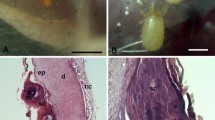Abstract
The stylostome of larvae of the trombiculids Leptotrombidium scutellare (Nagayo et al.), Leptotrombidium fletcheri (Womersley et Heaslip) and Leptotrombidium deliense (Walch) was studied experimentally at different time intervals after larval attachment using the histological method. The stylostome of these species has the same organization and belongs to the epidermal combined with the mixed type, developing more in width than in length. Neither transverse nor conspicuous longitudinal layers are present within the stylostome walls, which stain predominantly in red with Azan, also showing longitudinal portions with blue staining. Larvae tend to attach closely to each other and scabs, consisting of the hyperkeratotic epidermal layers fusing with migrating inflammatory cells, develop around the attachment sites. The dermis shows inflammatory foci with dilated capillaries and inflammatory cells inserting in the connective tissue layer underneath the stylostome. The feeding cavity, which is moderately expressed, may be found either in the epidermis or in the dermis. It contains inflammatory cells and their debris in the liquefied host tissues. The stylostome length depends on the character of the attachment site (the thicker epidermis or scab the longer the stylostome), and does not directly correspond to the stages of larval feeding. Nevertheless, at the 48-h time interval, nearly all attached larvae are found to be fully fed and their midgut cells are filled with nutritional globules.






Similar content being viewed by others
References
Åbro A (1979) Attachment and feeding devices of water-mite larvae (Arrenurus spp.) parasitic on damselflies (Odonata, Zygoptera). Zool Scr 8:221–234
Åbro A (1982) The effects of parasitic water mite larvae (Arrenurus spp.) on zygopteran imagoes (Odonata). J Invertebr Pathol 39:373–381
Åbro A (1984) The initial stylostome formation by parasitic larvae of the water mite genus Arrenurus on zygopteran imagines. Acarologia 25:33–45
Allred MA (1954) Observations on the stylostome (feeding tube) of some Utah chiggers. Utah Acad Proc 31:61–63
André M (1927) Digestion “extra-intestinale” chez le Rouget (Leptus autumnalis Shaw). Bull Mus Natn Hist Nat 33:509–516
Aoki T (1957) Histological studies on the so-called stylostome or hypopharynx in the tissues of the hosts parasitized by trombiculid mites. Acta Med Biol 5:103–120
Audy JR (1951) Trombiculid mites and scrub itch. Aust J Sci 14:94–96
Boese JL (1972) Tissue reactions at the site of attachment of chiggers. J Med Entomol 9:591
Cohen AC (1995) Extra-oral digestion in predaceous terrestrial Arthropoda. Ann Rev Entomol 40:85–103
Cohen AC (1998) Solid-to-liquid feeding: the inside(s) story of extra-oral digestion in predaceous Arthropoda. Am Entomol 44:103–116
Gomez-Puerta LA, Olazabal J, Lopez-Urbina MT, Gonzalez AE (2012) Trombiculiasis caused by chigger mites Eutrombicula (Acari: Trombiculidae) in Peruvian alpacas. Vet Parasitol 23:294–296
Hase T, Roberts LW, Hildebrandt PK, Cavanaugh DC (1978) Stylostome formation by Leptotrombidium mites (Acarina: Trombiculidae). J Parasitol 64:712–718
Hoeppli R, Schumacher HH (1961) Histological and histochemical reactions to trombiculid mites. Ann Rept Res Act Liber Inst 54–58
Hoeppli R, Schumacher HH (1962) Histological reactions to trombiculid mites, with special reference to “natural” and “unnatural” hosts. Zeitsch Tropenmed Parasitol 13:419–428
Jones BM (1950) The penetration of the host tissue by the harvest mite, Trombicula autumnalis Shaw. Parasitology 40:247–260
Jourdain S (1899) Le styloprocte de l’uropode vegetant et le stylostome des larves de Trombidion. Arch Parasitol 2:28–33
Kawamura A, Tanaka H, Tamura A (1995) Tsutsugamushi disease. University of Tokyo Press, Tokyo
Lillie RD (1969) Histopathological technique and practical histochemistry. Moscow, Mir publishing house (Translation to Russian)
Samter M (1971) Immunological diseases, 2nd edn. Little Brown, Boston
Schumacher HH, Hoeppli R (1963) Histochemical reactions to trombiculid mites, with special reference to the structure and function of the “stylostome”. Zeitsch Tropenmed Parasitol 14:192–208
Shatrov AB (2000) Trombiculid mites and their parasitism on vertebrate hosts. St.-Petersburg University Publishers, St.-Petersburg in Russian with English summary
Shatrov AB (2009) Stylostome formation in trombiculid mites (Acariformes: Trombiculidae). Exp Appl Acarol 49:261–280
Shatrov AB, Stekolnikov AA (2011) Redescription of a human-infesting European trombiculid mite Kepkatrombicula desaleri (Acari: Trombiculidae) with data on its mouthparts and stylostome. Int J Acarol 37:176–193
Stekolnikov AA, Santibáñez P, Palomar AM, Oteo JA (2014) Neotrombicula inopinata (Acari: Trombiculidae): a possible causative agent of trombiculiasis in Europe. Parasites Vectors 7:90. doi:10.1186/1756-3305-7-90
Voigt B (1970) Histologische Untersuchungen am Stylostom der Trombiculudae (Acari). Zeitsch Parasitenk Berlin 34:180–197
Wharton GW, Fuller HS (1952) A manual of the chiggers. Entomol Soc Wash 4:1–185
Acknowledgments
The authors gratefully thank to I.E. Borisenko (a graduate student of the St.-Petersburg State University) for his qualified help in histological methods. This study is supported by a grant N 12-04-00354-a from the Russian Foundation for Fundamental Research. Special thanks to anonymous reviewers for their qualified remarks and comments for improvement of this paper.
Author information
Authors and Affiliations
Corresponding author
Rights and permissions
About this article
Cite this article
Shatrov, A.B., Takahashi, M., Noda, S. et al. Stylostome organization in feeding Leptotrombidium larvae (Acariformes: Trombiculidae). Exp Appl Acarol 64, 33–47 (2014). https://doi.org/10.1007/s10493-014-9809-8
Received:
Accepted:
Published:
Issue Date:
DOI: https://doi.org/10.1007/s10493-014-9809-8




